Supply Chain Technician
Goals
Understand the role of the Supply Chain Technician.
Know how to create and manage inventory Items.
Know how to create and manage Kits.
Know how to use the BOM tab L7 MES.
Term | Definition |
Item | A resource that is consumed as part of a business process. Items are instances, or occurrences, of Item Types. |
Item Type | Defines the attributes of an Item, including its type (consumable or reagent), units, custom fields, Vendors, and ID Sequences. |
Kit | A physical kit that stores the Items intended to be used together during a process. Kit containers are instances, or occurrences, of Container Types that have "Is a Kit Type" selected. |
Container | A physical location that stores Entities, Items, Equipment and/or other Containers. Containers are instances, or occurrences, of Container Types. Examples include: freezer boxes, racks, bookcases, rooms, and buildings |
Container Type | Defines the attributes of a Container, including its content, dimensions, and custom fields. The Container Type builder is used to model both general Containers and Kits. |
BOM | The Bill of Materials (BOM) tab displays information about Kits associated with the Batch (Available Items) and the Items consumed during Batch production (Item Usage). |
L7 Assets App | L7 application used for location management of Containers, Kits, and Equipment. Formerly called L7 Locations app in earlier versions of L7|ESP. |
L7|ESP App | Activity | Permission |
|---|---|---|
L7 Inventory | Create new Items | Inventory & Billing → Item → Create |
L7 Inventory | Record Item Usage | Inventory & Billing → Item → Update |
L7 Assets | Create new Kits | Assets → Container → Create |
L7 Assets | Add Items to a Kit | Assets → Container → Update |
The Supply Chain Technician is responsible for managing inventory Items and Kits for manufacturing. To complete these tasks, they use the L7 Inventory and L7 Assets, respectively.
 |
Overview of L7 Inventory
Items are created in L7 Inventory and grouped by Item Type.
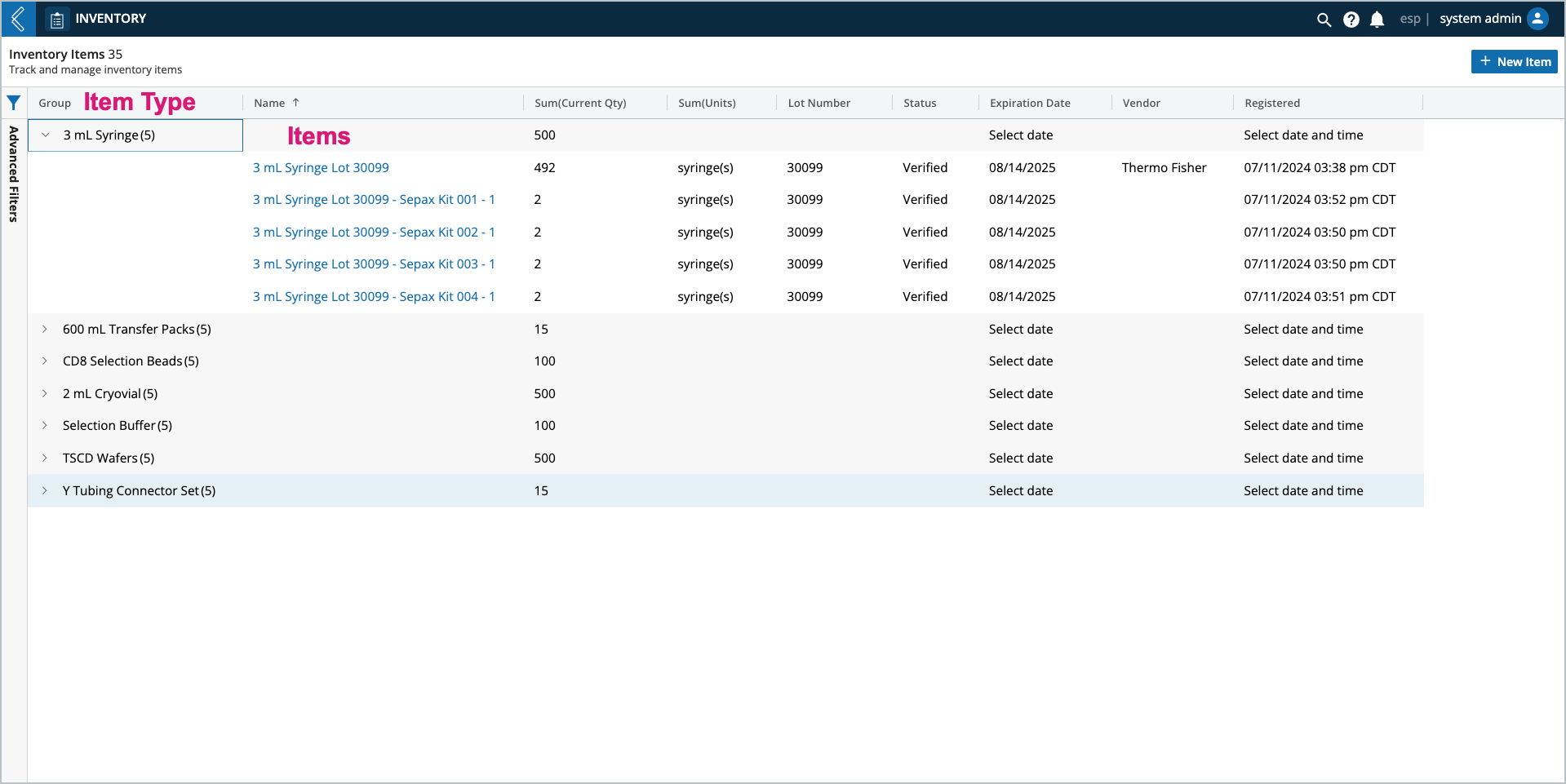
When you select an Item, you see:
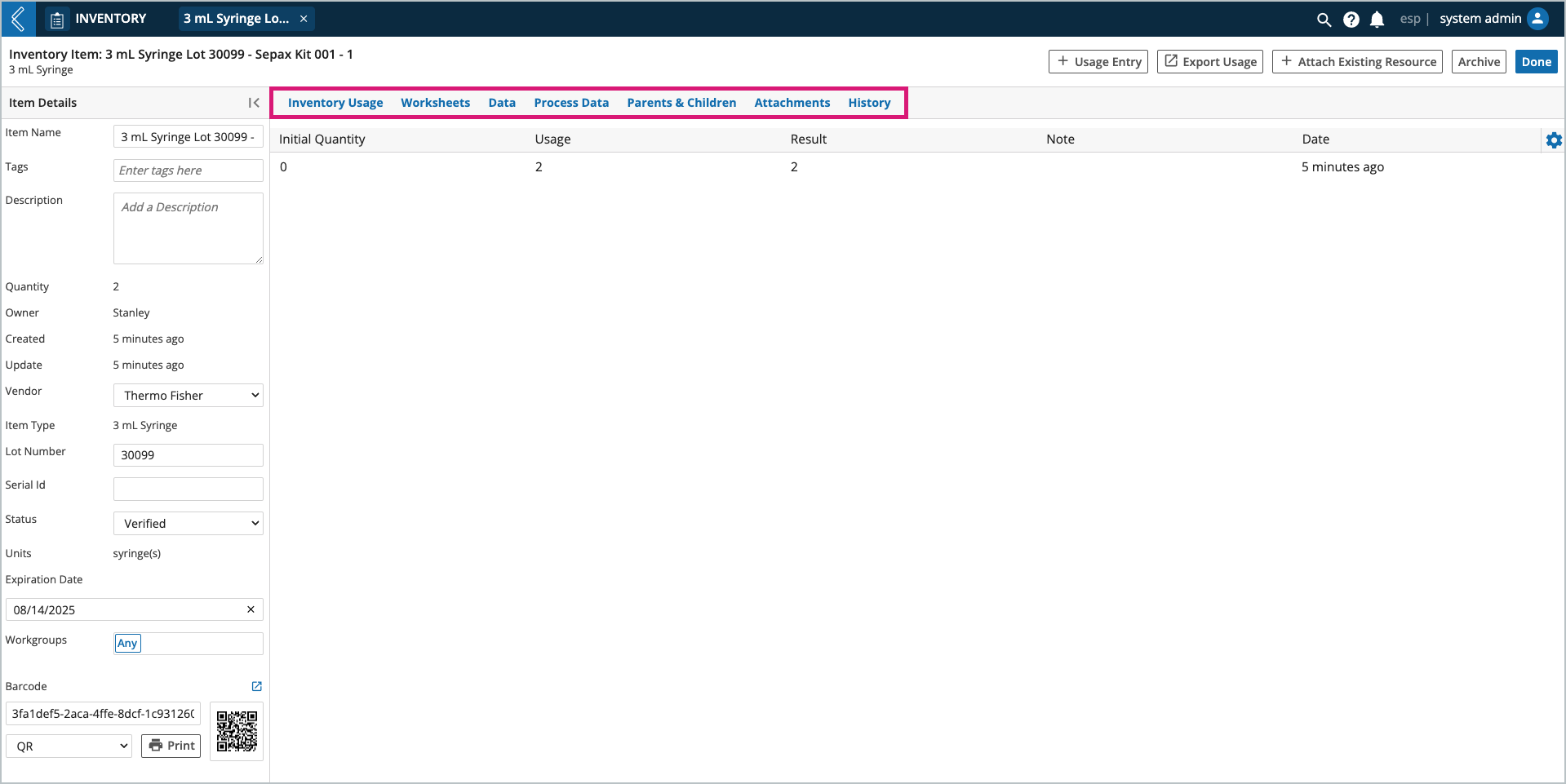
The Item’s usage history (Inventory Usage tab).
The Batches the Item is associated with (Worksheets tab).
The Item’s metadata (Data tab).
Production data associated with the Item (Process Data tab).
The Item’s relationship to other Entities (Parents & Children tab).
The files the Item is associated with (Attachments tab).
The Item’s history (History tab).
How to create new Items
Go to: L7 Inventory → + New Item
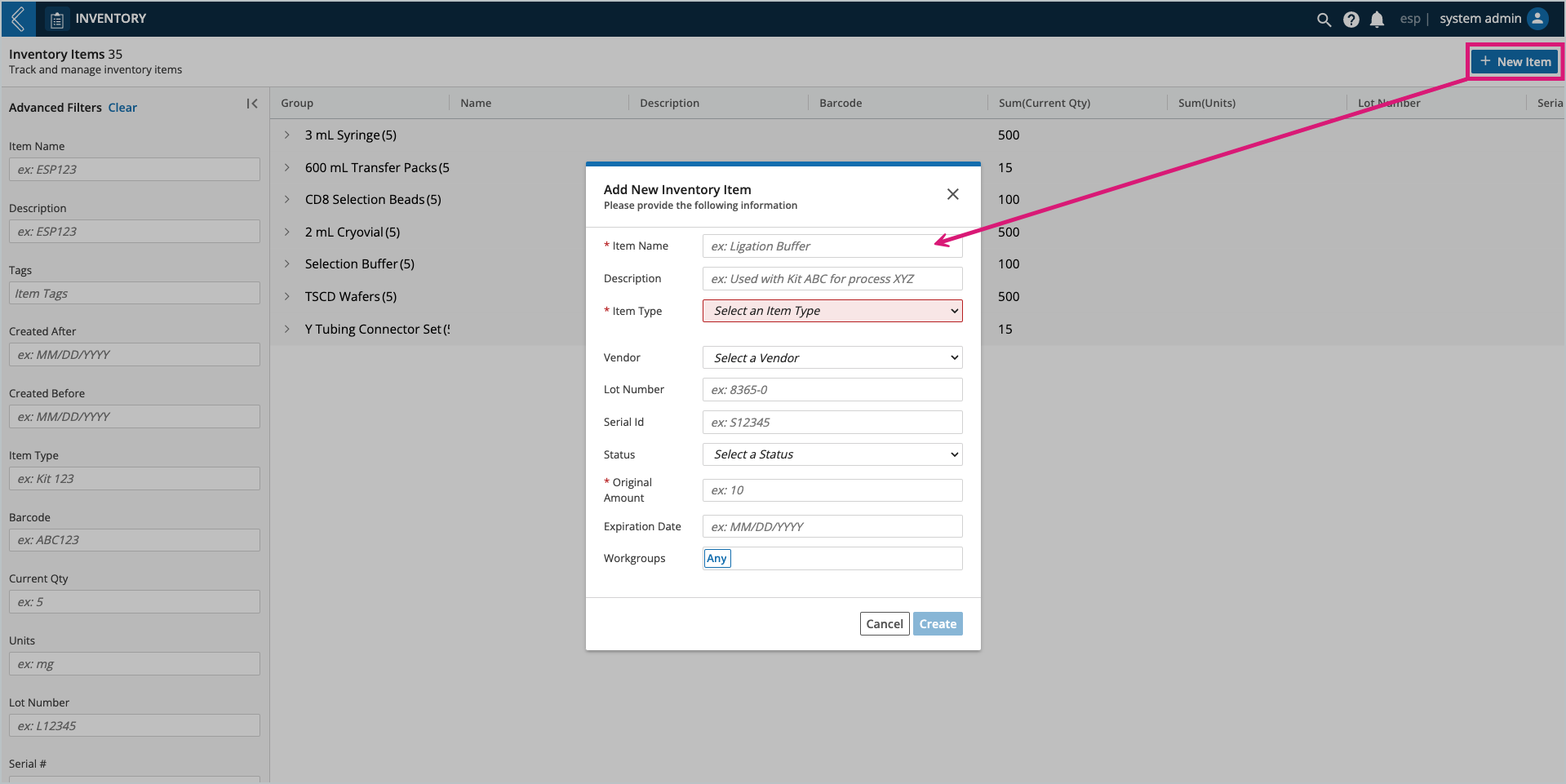
Recording Item usage
Item quantities can be adjusted independent of a business process by adding a usage entry.
Go to: L7 Inventory → Select an Item → + Usage Entry
You have the option to remove, add, or transfer Item quantities.
When transferring, you can move some or all of an Item to or from another Item of the same type. Both Items must also have the same lot number, status, and expiration date.
Transferring from another Item of the same type adds to the current Item’s quantity.
Transferring to another Item of the same type subtracts from the current Item’s quantity.
The corresponding addition/subtraction is also made to the other Item.
Tip
Transfers should be used to move Items from Kits back into available inventory.
L7|ESP will warn the user if the transfer will result in a negative quantity.
Note
L7|ESP will not warn the user if the deduction results in a negative quantity.
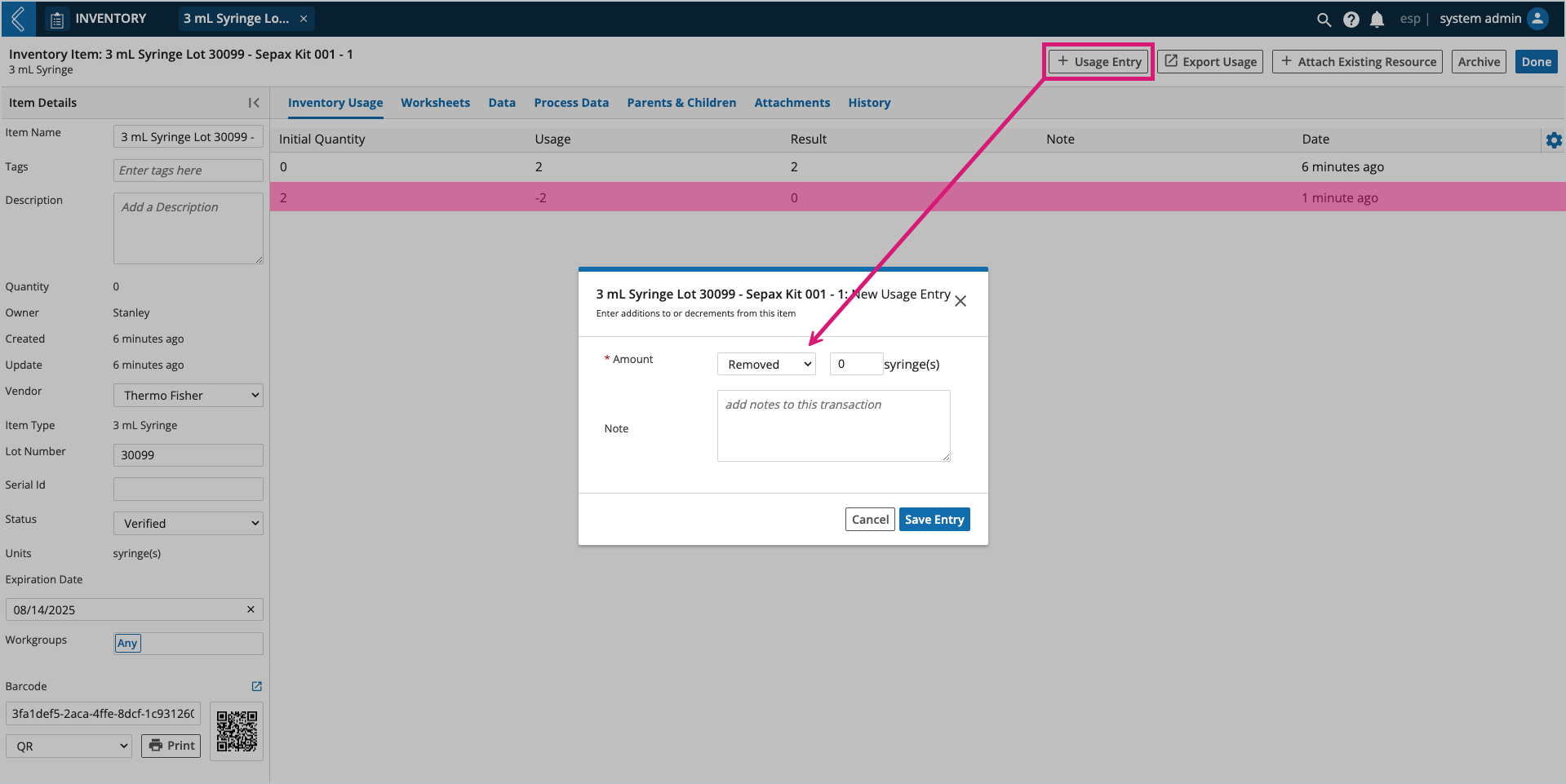
L7 Assets app overview
The L7 Assets app is used to manage Containers, Equipment, and Kits. You can register new Kits by going to their respective page, then clicking + Kit.
Once created, items can then be added to the Kit.
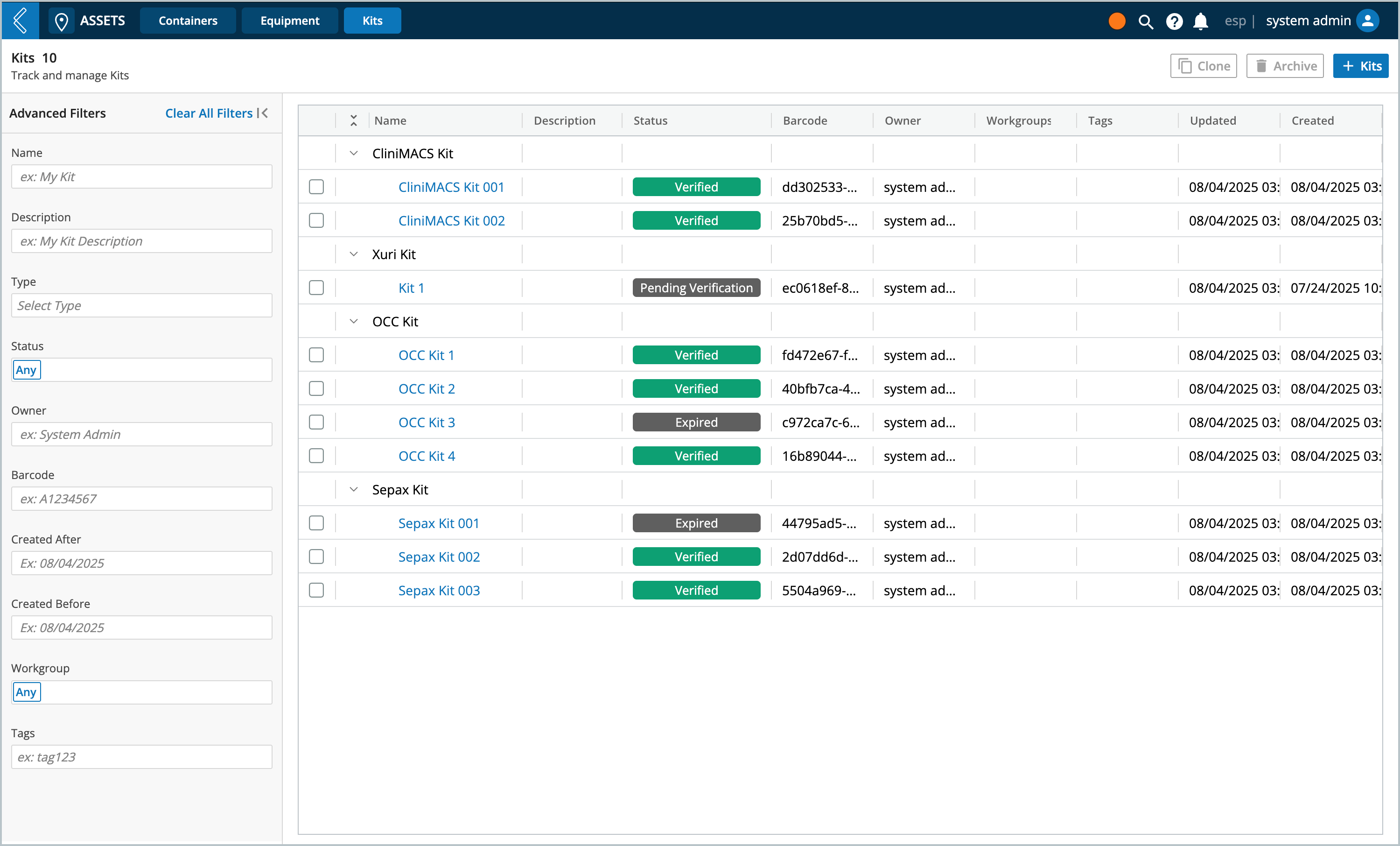
When you select a Kit, you'll see:
What can be, and what is stored in the Kit (Kit tab).
The Kit's metadata (Data tab).
Production data associated with the Kit (Process Data tab).
The files the Kit is associated with (Attachments tab).
The Kit's history (History tab).
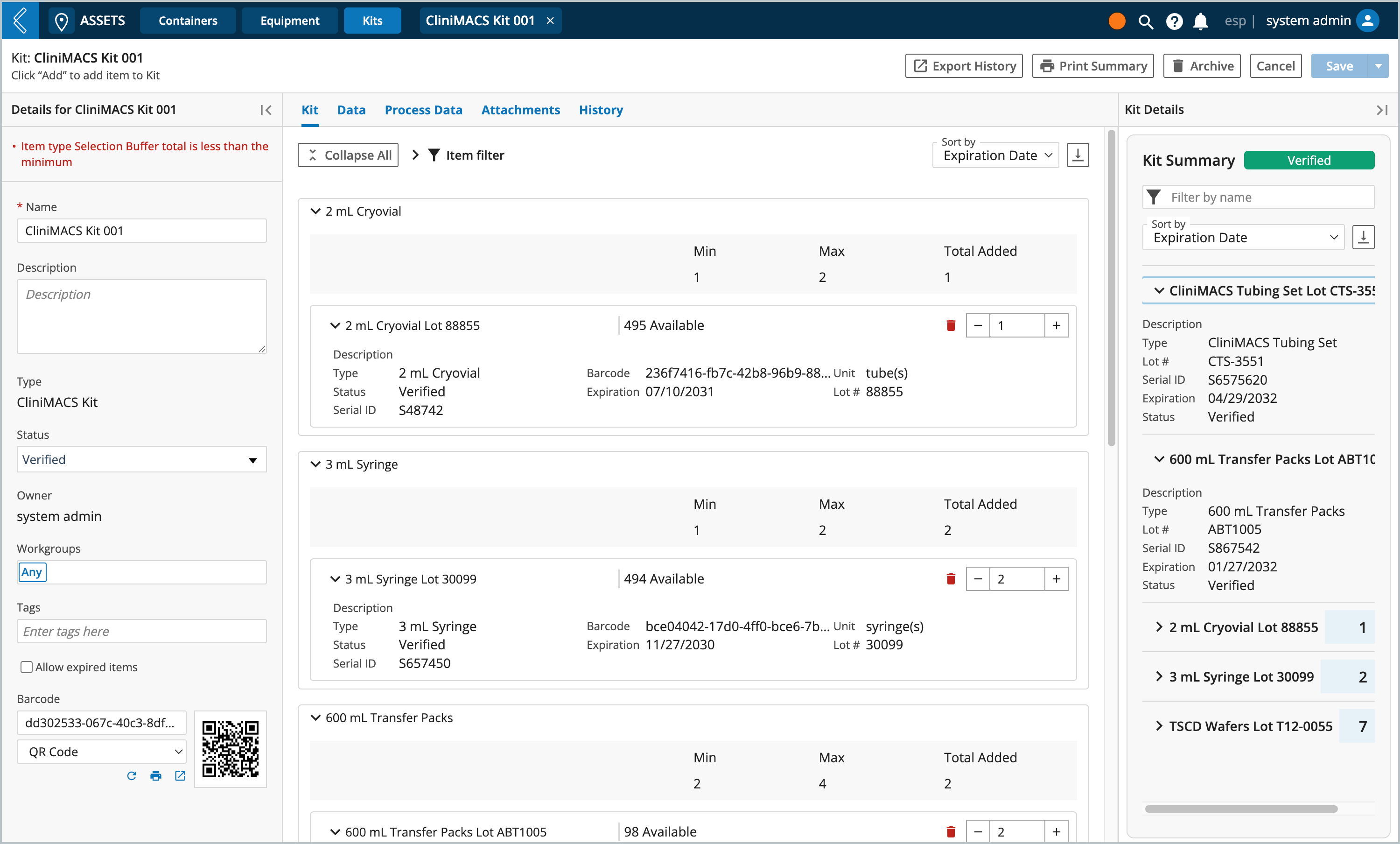
Creating new Containers (Kits)
Go to the Kits page in L7 Assets
Click + Kits
Enter a Name for the Kit (this name will be displayed on L7 MES's BOM)
Select what Type of Kit is being created
Select a Status (custom status options are configurable)
Note
Statuses can be used by Super Users in L7|Master to restrict which Kits (by status) can be used in a manufacturing process. The Kit’s status can be configured to change (e.g., Available → Unavailable) after the selection is saved. This prevents the same Kit from being assigned to more than one (1) Batch.
Optionally scan or enter a barcode
Optionally apply tags, workgroups and a description
Click Save
Assembling Kits
Select the Kit from the Kits page in L7 Assets
Add Items to the Kit, quantities must be within the specified ranges
Manually add Items by clicking + Add inline with the item you want to add, or
Scan each Item’s barcode
Tip
Scanning an Item will automatically add the minimum quantity and highlight the item that's been scanned into the kit.
Click Save
Note
Kits can't be saved until the minimum quantity has been added for every type of Item.
Printing Kit Summary reports
Select a Kit from the Kits page in L7 Assets
Click Print Summary
Go to L7 Data
Click the name of the Kit Summary PDF (will be named "Kit_Summary_" followed by the Kit's name)
Click Contents
View, download, and/or print the report
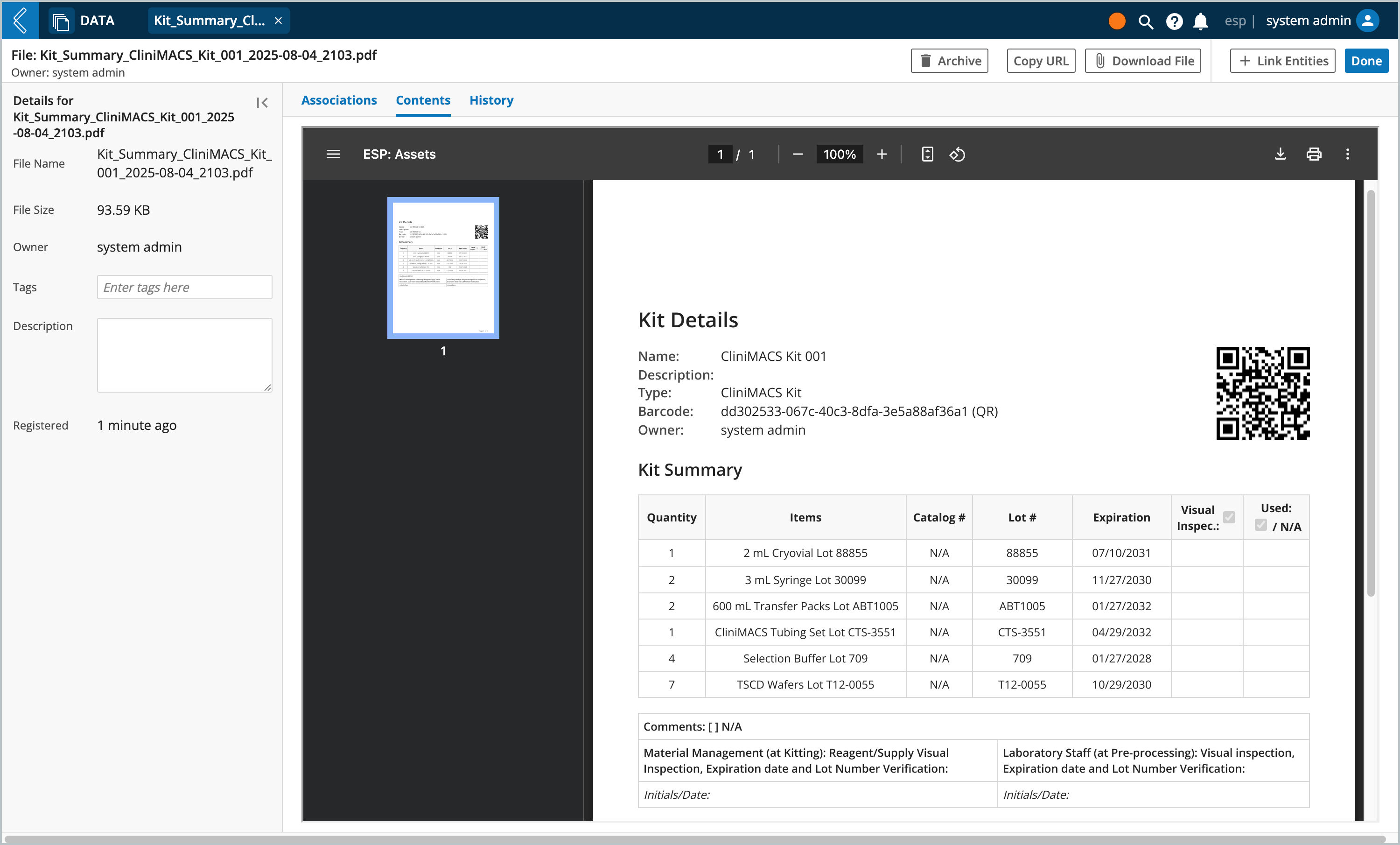
Note
The Kit Summary report includes a "Visual Inspec." and "Used" column intended for users who wish to print their report and physically record their responses with pen and paper.
Kit Summary reports can be configured by a Super User to group Items by a category (i.e., critical supplies or critical reagents), and add a column to record the Item's catalog number.
Adding Items to a Kit creates coalesced resources
Transferring an Item to a Kit will create a coalesced resource in L7 Inventory, which can then be tracked and consumed in L7 MES.
These "new" Items will retain the orignal stock Item's name with the name of the Kit it belongs to as the suffix.
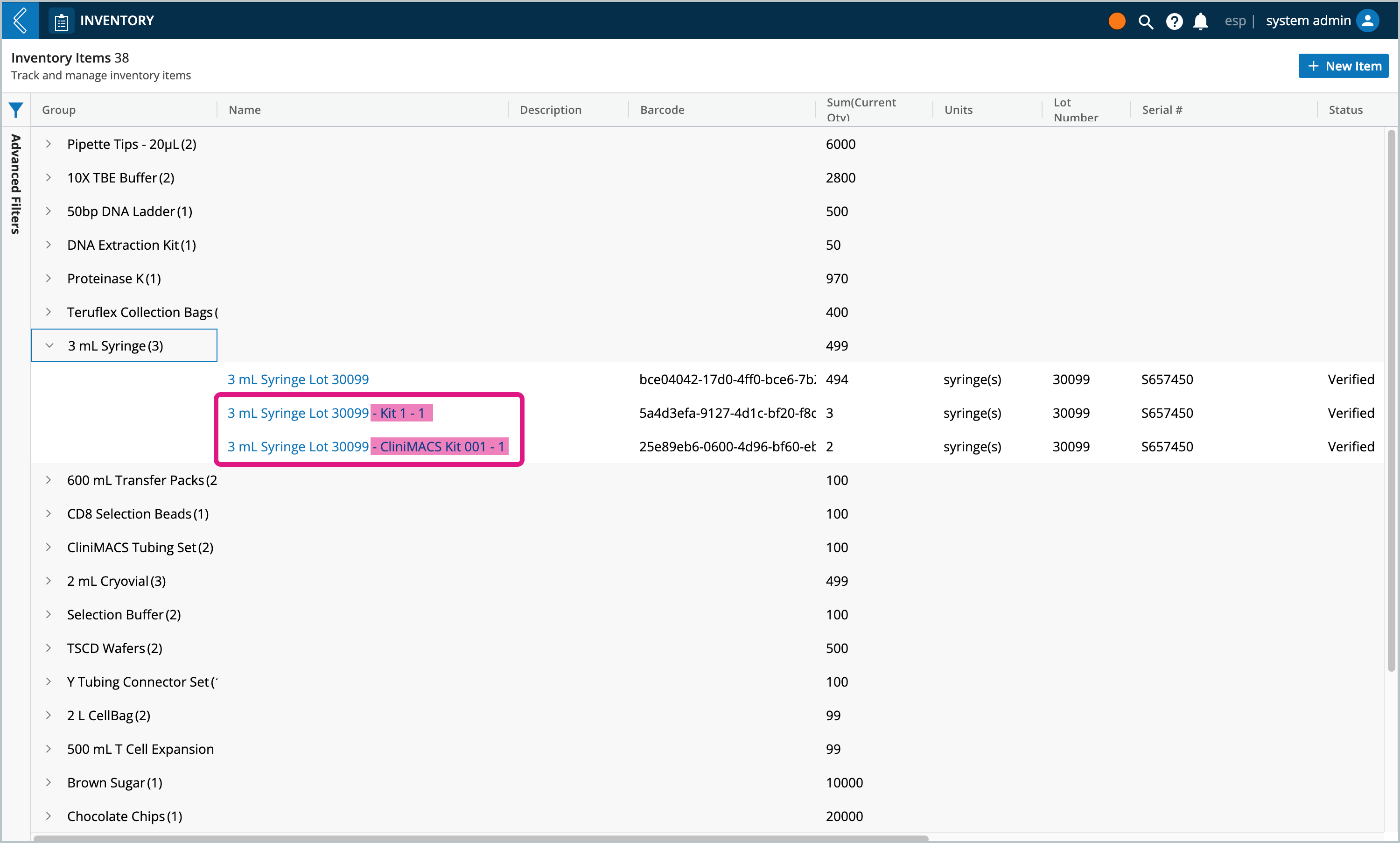
The Bill of Materials, or BOM tab, in L7 MES displays which kits and items are associated with the batch.
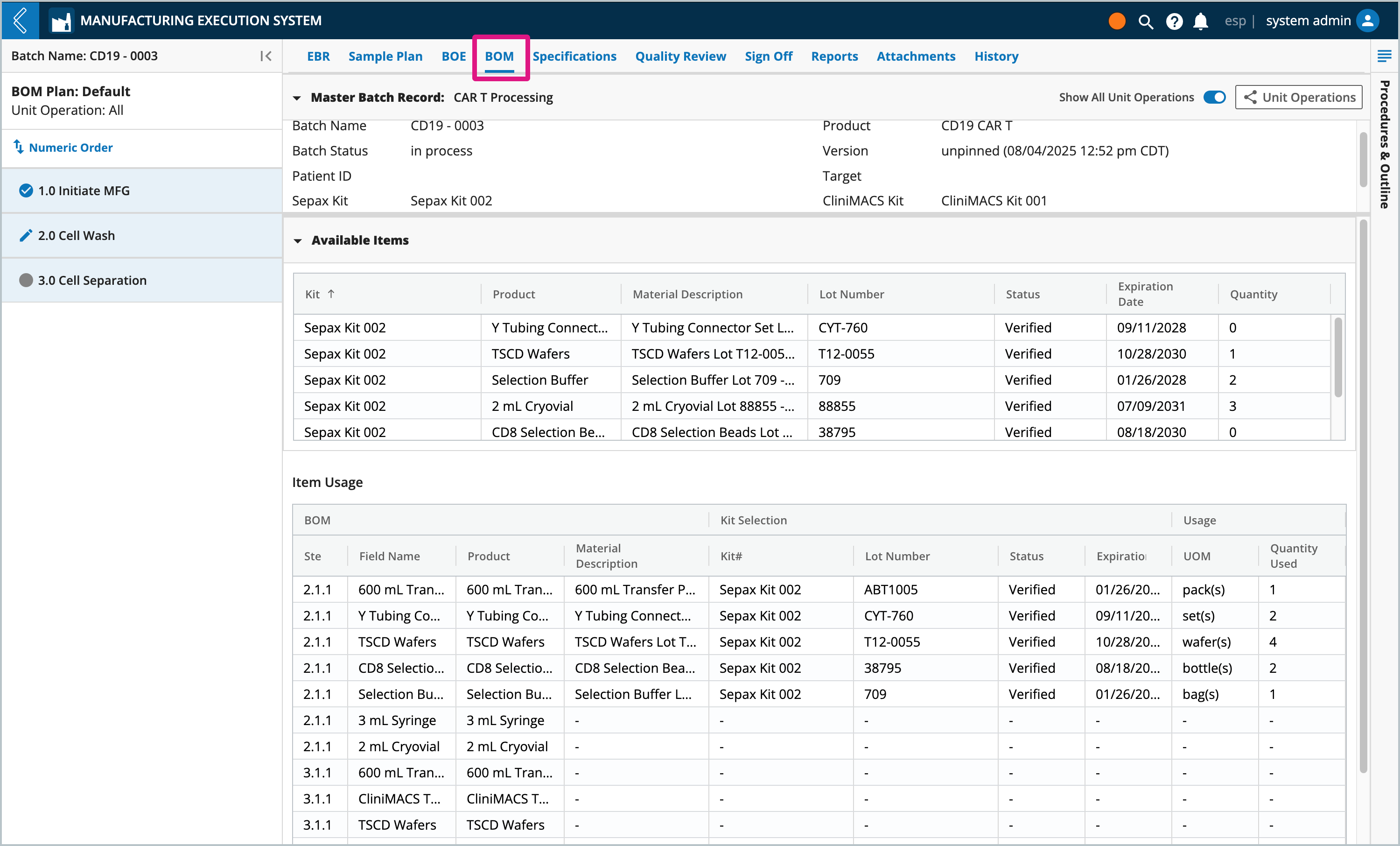
Available Items Table
When a Kit is used in L7 MES, a summary of its contents is listed under the BOM tab in the “Available Items” table. Select the Unit Operation in the left panel to populate the table with the Kit(s) used in that Unit of Operation.
To view all Unit Operations in the Batch, turn on Show All Unit Operations at the top of the tab.
Note
Items do not have to belong to a Kit to be used in L7 MES, but must be assigned to a Kit to appear in this table.
Item Usage Table
The “Item Usage” table tracks the quantity of each Item consumed in the Batch. Select the Unit Operation in the left panel to populate the table with the Item(s) consumed in that Unit Operation.
To view all Unit Operations in the Batch, turn on Show All Unit Operations at the top of the tab.
Note
Items can be tracked independent of quantity in L7 MES. For these Items, Unit of Measure (UOM) and Quantity Used are null and N/A, respectively.
Used Items that are not part of a kit will still appear in the Item Usage table.